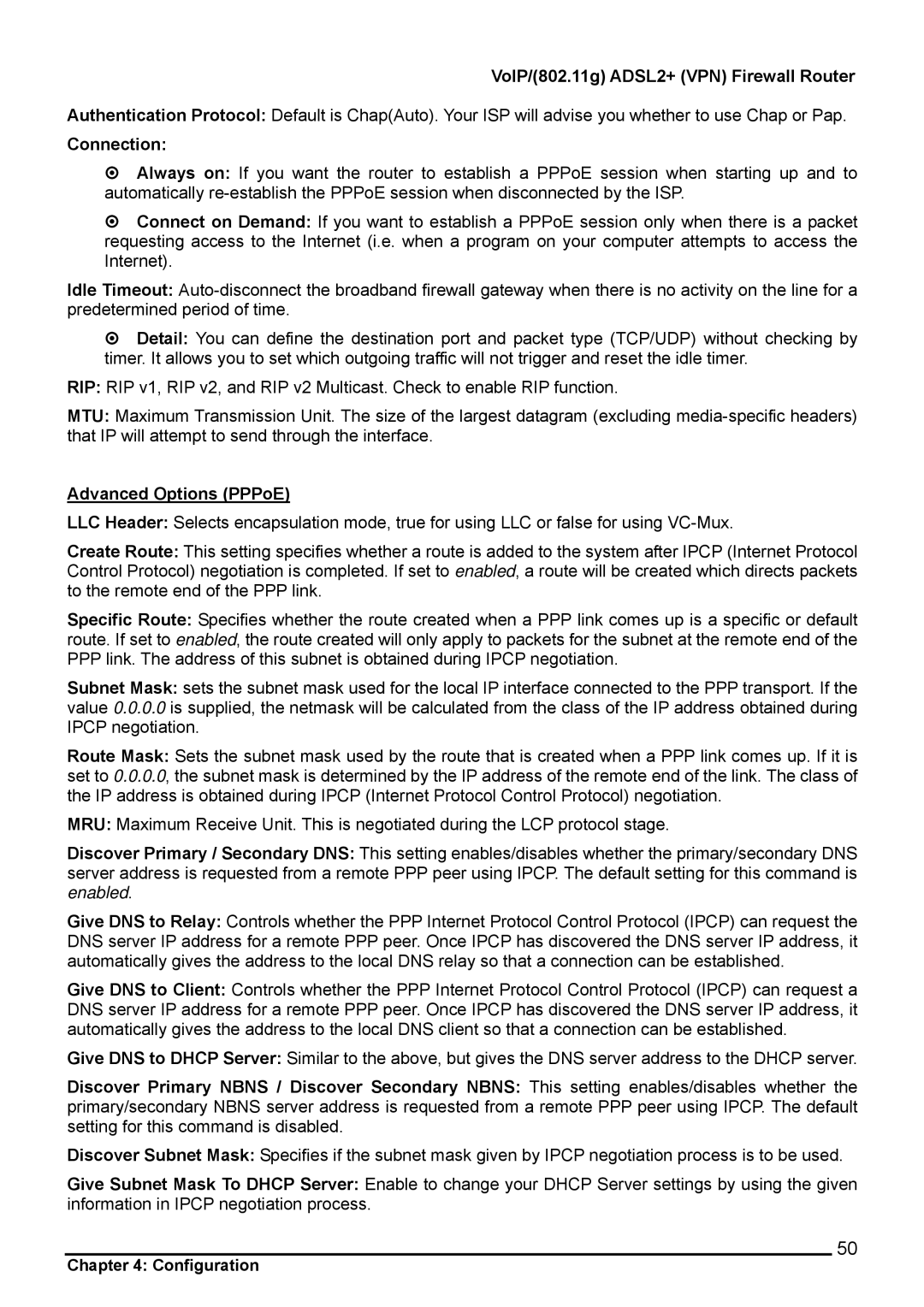VoIP/(802.11g) ADSL2+ (VPN) Firewall Router
Authentication Protocol: Default is Chap(Auto). Your ISP will advise you whether to use Chap or Pap.
Connection:
Always on: If you want the router to establish a PPPoE session when starting up and to automatically
Connect on Demand: If you want to establish a PPPoE session only when there is a packet requesting access to the Internet (i.e. when a program on your computer attempts to access the Internet).
Idle Timeout:
Detail: You can define the destination port and packet type (TCP/UDP) without checking by timer. It allows you to set which outgoing traffic will not trigger and reset the idle timer.
RIP: RIP v1, RIP v2, and RIP v2 Multicast. Check to enable RIP function.
MTU: Maximum Transmission Unit. The size of the largest datagram (excluding
Advanced Options (PPPoE)
LLC Header: Selects encapsulation mode, true for using LLC or false for using
Create Route: This setting specifies whether a route is added to the system after IPCP (Internet Protocol Control Protocol) negotiation is completed. If set to enabled, a route will be created which directs packets to the remote end of the PPP link.
Specific Route: Specifies whether the route created when a PPP link comes up is a specific or default route. If set to enabled, the route created will only apply to packets for the subnet at the remote end of the PPP link. The address of this subnet is obtained during IPCP negotiation.
Subnet Mask: sets the subnet mask used for the local IP interface connected to the PPP transport. If the value 0.0.0.0 is supplied, the netmask will be calculated from the class of the IP address obtained during IPCP negotiation.
Route Mask: Sets the subnet mask used by the route that is created when a PPP link comes up. If it is set to 0.0.0.0, the subnet mask is determined by the IP address of the remote end of the link. The class of the IP address is obtained during IPCP (Internet Protocol Control Protocol) negotiation.
MRU: Maximum Receive Unit. This is negotiated during the LCP protocol stage.
Discover Primary / Secondary DNS: This setting enables/disables whether the primary/secondary DNS server address is requested from a remote PPP peer using IPCP. The default setting for this command is enabled.
Give DNS to Relay: Controls whether the PPP Internet Protocol Control Protocol (IPCP) can request the DNS server IP address for a remote PPP peer. Once IPCP has discovered the DNS server IP address, it automatically gives the address to the local DNS relay so that a connection can be established.
Give DNS to Client: Controls whether the PPP Internet Protocol Control Protocol (IPCP) can request a DNS server IP address for a remote PPP peer. Once IPCP has discovered the DNS server IP address, it automatically gives the address to the local DNS client so that a connection can be established.
Give DNS to DHCP Server: Similar to the above, but gives the DNS server address to the DHCP server.
Discover Primary NBNS / Discover Secondary NBNS: This setting enables/disables whether the primary/secondary NBNS server address is requested from a remote PPP peer using IPCP. The default setting for this command is disabled.
Discover Subnet Mask: Specifies if the subnet mask given by IPCP negotiation process is to be used.
Give Subnet Mask To DHCP Server: Enable to change your DHCP Server settings by using the given information in IPCP negotiation process.
50
Chapter 4: Configuration
